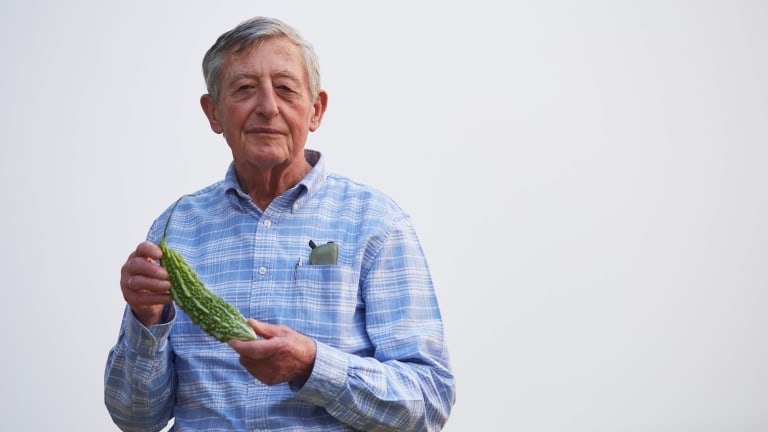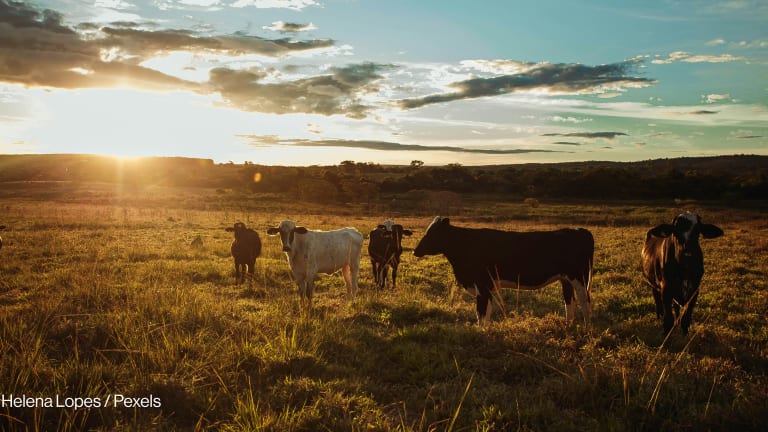How to realize the potential of digital extension services for farmers
Researchers, donors, and practitioners are narrowing in on best practices for leveraging mobile phones to provide targeted, actionable, and customized information to smallholder farmers.
While smallholder farmers produce one-third of the world’s food, many of them live in poverty. A key challenge they face is a lack of access to information to improve their farming practices. As a cost-effective way to help smallholder farmers increase their yields, a growing number of so-called digital extension services are using mobile phones and tools like text messaging, apps, and audio or video calls or messages. The story of digital extension tools, and mobile platforms more generally, is one of creating small benefits for large numbers of people at a low cost, said Craig McIntosh, a professor and co-director of the Policy Design and Evaluation Lab at the University of California, San Diego. His research on a mobile trading platform that uses text messaging to link potential buyers and sellers for food crops in Uganda found that the benefits were greater for larger- versus smaller-scale farmers. Studies rarely find that digital extension services offer transformative impacts on an individual level, according to McIntosh. But these tools may still offer an appealing benefit-cost ratio if they go to scale. Since only a handful of them have done so, however, there is frustration over the many failed pilots in digital extension services, McIntosh said. “You’re seeing a lot of platforms that are paid for with external funding and only a few cases where the cost recovery is achievable,” he said. “If you’re going to benefit somebody a few dollars, and you’re going to set up a half-a-million-dollar platform to do that, there's no intermediate success story. Either you get to national scale and you’ve got an enormous service that you can recoup through small user fees, or you go under because you don’t get big enough.” As McIntosh’s research highlights, some tools have faced criticism for not delivering on their potential. Efforts are underway to evaluate what does and what doesn’t work. Researchers, donors, and practitioners alike are narrowing in on the best ways of leveraging mobile phones to provide targeted, actionable, and customized information to smallholder farmers. These emerging insights could add value not only for agriculture, but for a wide range of efforts to provide information at low cost and at scale, from health to education. Precision Development, or PxD, launched in 2016 with a goal of bringing rigorous testing to the sector and ensuring that lessons from the field do not just remain in academic papers. The organization is now generating evidence on digital extension services, as well as other digital knowledge-sharing services, with the goal of scaling up successful programs and discontinuing unsuccessful ones. Its largest service is Ama Krushi, an advisory program delivered in partnership with the government of Odisha, India. Ama Krushi provides 2 million farmers in the state with information on crops, fisheries, livestock, poultry, and kitchen gardens. A weekly advisory service sends information to farmers that is tailored to their needs, and they can also place a call to Ama Krushi’s inbound service that will be answered by an expert agronomist. Now, PxD is working on plans to hand over the day-to-day management of the service to a company that is contracted to the government. This could be a model for how donor funding can provide the risk capital for designing, iterating, and scaling a quality information delivery service, without “indefinitely supporting the work,” said Niriksha Shetty, India country director at PxD. In an email to Devex, she outlined three additional lessons from PxD’s efforts in India. First, it’s critical to start by understanding what problems farmers face and then develop the digital extension services that meet their needs. “This is part of our approach at PxD when we say we are technology agnostic, so a voice-based service will work in some settings but videos may work better in others. What is imperative is that we design tools that farmers can use. This approach is not just restricted to technology,” Shetty said. Beyond the platform, other important considerations include what content is being sent, how often, and in what format. A second lesson is the importance of continuous learning and iteration, Shetty said. “Farmer needs are not static, and as their needs evolve, information services catering to them must evolve too,” she said. For example, while growing smartphone use can open up more opportunities for customization, a higher level of technological sophistication for a digital extension service can lead to a greater risk of leaving out farmers who may need such a service the most. “Lastly, I think we must keep in mind the do-no-harm principle,” Shetty said. When farmers make decisions based on the information sent to them — like when to plant, based on changing weather patterns — there are serious risks involved. “We need to spend time understanding how people understand probabilistic language in a given context, how confident we are in the accuracy of the forecast, at what threshold do we feel confident in making an agronomic recommendation,” Shetty said. Organizations need to be transparent about the risks associated with the advice they provide, and they should determine the best ways to communicate that to farmers, she said. Mobile phones have the potential to reach a large number of people at low cost, while also allowing for two-way communication, but those benefits have not been fully realized by many digital extension services, said Raissa Fabregas, an assistant professor of economics and public affairs at the Lyndon B. Johnson School of Public Affairs at The University of Texas at Austin. Some agricultural technology companies are still using mobile phones more like radios — broadcasting information rather than hearing from farmers and providing customized information based on their needs, she said. Fabregas, who has researched how the spread of smartphones could increase the benefits of digital extension services, said most of the evidence related to this sector is based on current technologies. The integration of more advanced technologies, from remote sensing to machine learning, could improve the quality and impact of agricultural advice, she said. While few digital extension services have gone to massive scale, Stewart Collis, senior program officer for digital agriculture solutions at the Bill & Melinda Gates Foundation, said he’s optimistic about the potential of this approach to improve the lives of smallholder farmers. “Farmer needs are not static, and as their needs evolve, information services catering to them must evolve too.” --— Niriksha Shetty, India country director, PxD “You have to put it in context. It’s not a panacea. It’s not going to solve all problems,” he said. “We see it as an accelerator of the broader agricultural transformation strategy that we have.” Collis recently co-authored a piece in which he outlined promising trends that are enabling digital technology adoption among smallholder farmers — including the decreasing cost of smartphones, the growth of social media and other digital services, and advances in artificial intelligence for automated services — as well as barriers, including low literacy and technology skills, affordability, and difficulties in ensuring timely and relevant information. The Gates Foundation is increasing its investments in digital agricultural solutions, particularly as they relate to climate adaptation, said Collis, citing research by the Global Commission on Adaptation about the impact of digital tools that integrate climate-related information into agricultural decision-making. Collis acknowledged that more evidence is needed for digital extension services, as well as other bundled services. The Gates Foundation is funding efforts to build that evidence base, including by supporting PxD. Collis said he hopes to see leaner and faster ways to evaluate these digital tools, so that organizations can access more real-time data to pivot their products and services.
While smallholder farmers produce one-third of the world’s food, many of them live in poverty. A key challenge they face is a lack of access to information to improve their farming practices.
As a cost-effective way to help smallholder farmers increase their yields, a growing number of so-called digital extension services are using mobile phones and tools like text messaging, apps, and audio or video calls or messages.
The story of digital extension tools, and mobile platforms more generally, is one of creating small benefits for large numbers of people at a low cost, said Craig McIntosh, a professor and co-director of the Policy Design and Evaluation Lab at the University of California, San Diego.
This story is forDevex Promembers
Unlock this story now with a 15-day free trial of Devex Pro.
With a Devex Pro subscription you'll get access to deeper analysis and exclusive insights from our reporters and analysts.
Start my free trialRequest a group subscription Printing articles to share with others is a breach of our terms and conditions and copyright policy. Please use the sharing options on the left side of the article. Devex Pro members may share up to 10 articles per month using the Pro share tool ( ).
Catherine Cheney is the Senior Editor for Special Coverage at Devex. She leads the editorial vision of Devex’s news events and editorial coverage of key moments on the global development calendar. Catherine joined Devex as a reporter, focusing on technology and innovation in making progress on the Sustainable Development Goals. Prior to joining Devex, Catherine earned her bachelor’s and master’s degrees from Yale University, and worked as a web producer for POLITICO, a reporter for World Politics Review, and special projects editor at NationSwell. She has reported domestically and internationally for outlets including The Atlantic and the Washington Post. Catherine also works for the Solutions Journalism Network, a non profit organization that supports journalists and news organizations to report on responses to problems.








